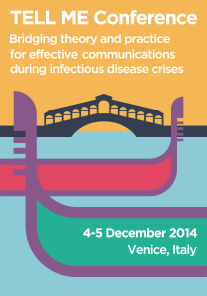Flu from A to Z
For centuries the communication strategy adopted by authorities dealing with infectious outbreaks was chiefly based on denial and verbal reassurances, followed, in a further phase, by restrictive measures (quarantine, isolation, compulsory hospitalization) and sanctions for non compliant individuals. During the 19th century, the severe threat of contagious diseases provided a justification for the exercise of compulsory public health powers. As the most frightening epidemics of the 19th century, such as smallpox and cholera, regressed, coercive measures became more limited in scope and less frequent. The increasing recognition that human behaviour critically influences infectious disease transmission led to concentrate efforts on education and prescriptive messages. Yet recommendations were soon recognized as insufficient, people needed to be also “persuaded” by emotional messages. The focus then shifted on public health propaganda. Nowadays, our interconnected world represents both a challenge and an opportunity for public health, and such a challenge requires the development of new communication strategies.
Early Warning
Early warnings represent a crucial step for an effective risk communication strategy. Unfortunately, they are often incomplete and misleading, and the early communication messages can potentially carry a relevant risk which is contradicted later or not to confirm the level of attention the first news required; There are several factors that make early messages particularly weak: authorities’ tendency not to be fully transparent, technical protagonist from scientists that don’t want to miss the occasion to appear on the media, lack of time to carry out full diagnostic procedures, inadequate use of an epidemiological model based on early incomplete information. Improving the effectiveness of early warning is thus a key topic when developing new communication strategies.
Decide-Announce-Defend (DAD)
DAD is the Decide-Announce-Defend management approach, sometimes ending up as DADA (Decide-Announce-Defend-Abandon). It is based on the analysis of an issue by a group of experts, whose decisions will be get made through a well-defined hierarchy, even if not everyone agrees with them.
This approach is considered a good method for emergencies, due to its quickness, but is not well suited to a) situations where a wide range of technical, social, cultural and economic factors are influencing the current situation and the various possible alternatives to it; b) where successful implementation involves a lot of people; c) where these people are not in an obvious command structure, but can choose whether to cooperate.
In some contexts – traffic congestion, water supply, domestic energy use, waste reduction, renewable generation, flood risk management – the DAD approach is guaranteed to generate resistance to even the best ideas. Resistance eats up time and resources because it needs a response. The time spent overcoming resistance and defending the solutions against opponents often delays implementation and can lead to the plans being abandoned.
See also Command and Control.
Command and Control
Command and control is a military-derived term that refers to “the exercise of authority and direction by a properly designated commander over assigned and attached forces in the accomplishment of the mission”, as described by the US DoD Dictionary of Military and Associated Terms. In management, it refers more generally to the maintenance of authority with somewhat more distributed decision making. The TELL ME project believes that this top-down approach is no longer tenable in health management since it has not adapted to the stream of information that flow through our interconnected world.
New and more appropriate communication strategies require a participatory governance, where different stakeholders are involved and engaged in a two-way dialogue.
Transparency
When referring to media, transparency is the concept of determining how and why information is conveyed through various means. In government, transparency is the capability to put in place national communication guidelines on the public announcements and to keep the flow of information constantly updated. Transparency contributes to a better dissemination of information, which in turn assists producing greater knowledge and social progress. Particularly, by strengthening trust in the institutions, it can be of great help when dealing with risk communication.
Sensationalism
Sensationalism is a kind of editorial approach that consists of exaggerating some elements of the news to increase its appeal to the audience. It usually relies on the misrepresentation of events, the omission of facts, the exaggeration of minor details and the appeal to emotion. Such an approach may be particularly dangerous in health communication since it could generate false alarmism or, on the other hand, false illusions toward a possible cure to a disease.
Social Media
Mass media can facilitate information flow, but effective communication must also be two-way and interactive. Nowadays, we can rely on a vast array of electronic media, ranging from Internet forums to blogs, from instant messaging to social networks. Many of these social media services can be integrated through aggregation platforms. As a result, in the globalised, interconnected world, neighbourly – although “electronic neighbourly” – is becoming an essential value and this is extremely relevant to outbreak communication as well.
Misinformation
Misinformation is false or inaccurate information that is spread unintentionally. It should not be confused with disinformation, which is different for its motive: whilst misinformation is a bona fide mistake, disinformation is, in contrast, intended to mislead.
Distrust
Distrust (or mistrust) is defined as a formal way of not trusting any one party too much in a situation of grave risk or deep doubt. It is clearly a main concern for those involved in risk communication, since a lack of trust in those institutions that are responsible for risk management may lead to misinformation, disinformation and the generation of urban myths.


